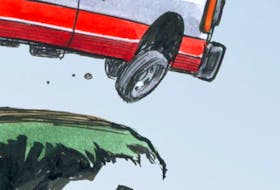Being on an island has some unique advantages.
Among them?
It can keep our neighbours’ problems out, at least for a while.
For example, the moat of ocean that separates the island of Newfoundland from the mainland kept us from having to deal with coyotes for years (sadly, those days are past).
Other pests have not been as successful in getting here. It’s meant we don’t have raccoons — Ontario’s “trash pandas”— finding their ways into our neighbourhoods, for example.
Our bees don’t suffer from the Varroa mite, which weakens and threatens honey bee populations across the rest of North America.
Moose and caribou here aren’t tormented by ticks the way they are in parts of mainland Canada — and we’re less likely to have to contend with Lyme disease-carrying ticks.
Rabies is only an occasional visitor.
Infected bats behave oddly, try to feed during periods when they should be staying in hibernation, and don’t survive the winter.
But things change, and problems sometimes do arrive.
And sadly, they’ve changed in a potentially catastrophic way for Newfoundland’s bats.
For years, white-nose syndrome has been hammering bat populations across North America. Hibernating bats develop fungal patches, especially visible on their noses, that damage their wing tissue and affect their internal organs. Infected bats behave oddly, try to feed during periods when they should be staying in hibernation, and don’t survive the winter.
Three little brown myotis bats have been found with the disease on the west coast of the province, with the most likely source being Cape Breton.
Brown bats on the island are already an endangered species.
Now, you may not be fond of bats, especially given their bad press in movies. In fact, the provincial government has even gone so far as to spell out a list of bat myths in an effort to quell people’s fears, saying, “Bats have long been associated with vampires, Halloween and things that go bump in the night. Most fear of bats is based not on fact but on myths, legends and superstition. Fear of bats subsides with knowledge and accurate information.”
But just one little brown bat can eat up to 1,200 mosquito-sized bugs every hour — the critters dine on a broad range of night- and evening-flying pests. Some biologists refer to bats as a keystone species, because of the huge role they have in controlling a broad range of insect pests.
Here, bats were facing threats enough, with loss of habitat and with the improper destruction of colonies that sometimes form in homes and cabins. White-nose fungus is a far more serious problem, and even though the number of infected bats found so far has been small, the mere arrival of the disease could be a death knell.
It’s would be a sad fate for one of the species that has called this island home for generations. Little brown bats are one of only 15 mammal species native to the island of Newfoundland.








